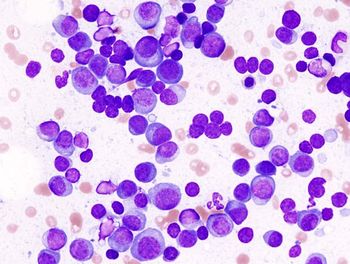
- Oncology Vol 28 No 4_Suppl_1
- Volume 28
- Issue 4_Suppl_1
(S007) Stereotactic Radiosurgery to the Brain With Concurrent BRAF Inhibitors for Melanoma Metastases
Linear accelerator-based stereotactic radiosurgery (SRS) is an effective treatment for selected melanoma patients with brain metastases. Recently, BRAF inhibitors have shown efficacy in stage IV melanoma. We sought to determine the effectiveness of SRS in patients with melanoma who are also being treated with BRAF inhibitors.
Nicholas Figura, BS, Kamran Ahmed, MD, Jessica Freilich, MD, Jeffrey Weber, MD, PhD, Geoffrey Gibney, MD, Ragini Kudchadkar, MD, Siriporn Sarangkasiri, MS, Prakash Chinnaiyan, MD, Arnold Etame, MD, PhD, Nikhil Rao, MD; Moffitt Cancer Center
Purpose and Objectives: Linear accelerator-based stereotactic radiosurgery (SRS) is an effective treatment for selected melanoma patients with brain metastases. Recently, BRAF inhibitors have shown efficacy in stage IV melanoma. We sought to determine the effectiveness of SRS in patients with melanoma who are also being treated with BRAF inhibitors.
Materials and Methods: An analysis of patients with metastatic melanoma treated with SRS while on BRAF inhibition was performed. All patients were treated with BRAF inhibitors within 3 months of their SRS treatment and were asked to stop the drug 1–2 days before and after SRS. MRI scans were reviewed post-SRS to evaluate local control (LC). Toxicity was recorded. Disease progression by imaging was defined by the 2009 Response Evaluation Criteria in Solid Tumors (RECIST) criteria. Survival curves were calculated according to the Kaplan-Meier (KM) method from the date of diagnosis of brain metastases or the date of SRS.
Results: We identified 41 metastatic melanoma brain lesions treated in 13 patients. The median age was 49 years (range: 33–74 yr). All patients presented with extracranial metastases. Three patients (23.1%) were diagnosis specific-graded prognostic assessment (DS-GPA) class 0, three patients (23.1%) were DS-GPA class 1, and seven patients (53.8%) were DS-GPA class 2. The median planning target volume (PTV) was 0.47 cm3 (range: 0.05–4.19 cm3), and lesions were treated to a median dose of 24 Gy (range: 16–24 Gy). The median lesion diameter was 8 mm (range: 3–21 mm). One patient received whole-brain radiation therapy (WBRT) prior to SRS. Two patients underwent two courses of SRS, and another two patients were treated with three courses of SRS while on BRAF inhibitors. The median follow-up was 9 months (range: 2.5–26.8 mo). Four of the 41 (9.8%) lesions showed progression by MRI at a median of 19.1 months following SRS (range: 11.8–20.1 mo); this occurred in three patients, all of whom underwent surgical resection. The pathology examination confirmed radiation necrosis in one lesion and tumor progression in three lesions. After SRS, there was no evidence of intracranial hemorrhage, scalp reactions, or other radiation-related acute toxicity. KM local control estimates at 6 and 12 months were 100% and 90.9%, respectively, for treated lesions. Ten (71.4%) patients were noted to have distant failure in the brain, with four of these patients showing disease progression systemically. Of the patients with distant brain failure, two patients received WBRT, and six patients received additional SRS. Median overall survival (OS) was 19.2 months (range: 5.5–27.2 mo) and 18 months (range: 5.1–26.1 mo) from the date of diagnosis of brain metastases and the date of SRS, respectively. The KM OS estimates at 6 and 12 months were 84.6% and 76.9%, respectively, from the time of SRS treatment. OS according to DS-GPA class at 12 months was 90.0% and 33.3% for classes 1–2 and 0, respectively (P = .02).
Conclusions: SRS to cranial melanoma metastases appears to be both safe and effective for patients treated concurrently with systemic BRAF inhibitors. In our series, we report acceptable local control and no evidence of increased toxicity.
Proceedings of the 96th Annual Meeting of the American Radium Society -
Articles in this issue
Newsletter
Stay up to date on recent advances in the multidisciplinary approach to cancer.

















































































